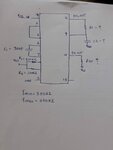Wicky21
Newbie level 6
I'm currently doing a project by using the HEF4046B pll. i'm new to this chip
My requirement is to lock the PLL around 350Hz-550Hz. Simply my capturing range should be between 350Hz-550Hz. Since i'm new to this pll somebody help me to select R2,R1 and C1 values. Also to design low pass filter.
I'm using a Adafruit AGC Electret Microphone Amplifier - MAX9814 to pick signals.
below links shows out the datasheet of the pll
https://assets.nexperia.com/documents/data-sheet/HEF4046B.pdf
I gone through with the data sheet and selected values. somebody please tell me whether selected values are correct.
Vdd = 5V
Fmin = 350Hz , Fmax = 550Hz
C1 = 30nF
R2 = 100Kohm
R1 = 200Kohm
I thought to use phase comparator 2. I'm bit confusing how to select low pass filter values(R3, C2). And what is the purpose of Rsf resistor?
My requirement is to lock the PLL around 350Hz-550Hz. Simply my capturing range should be between 350Hz-550Hz. Since i'm new to this pll somebody help me to select R2,R1 and C1 values. Also to design low pass filter.
I'm using a Adafruit AGC Electret Microphone Amplifier - MAX9814 to pick signals.
below links shows out the datasheet of the pll
https://assets.nexperia.com/documents/data-sheet/HEF4046B.pdf
I gone through with the data sheet and selected values. somebody please tell me whether selected values are correct.
Vdd = 5V
Fmin = 350Hz , Fmax = 550Hz
C1 = 30nF
R2 = 100Kohm
R1 = 200Kohm
I thought to use phase comparator 2. I'm bit confusing how to select low pass filter values(R3, C2). And what is the purpose of Rsf resistor?
